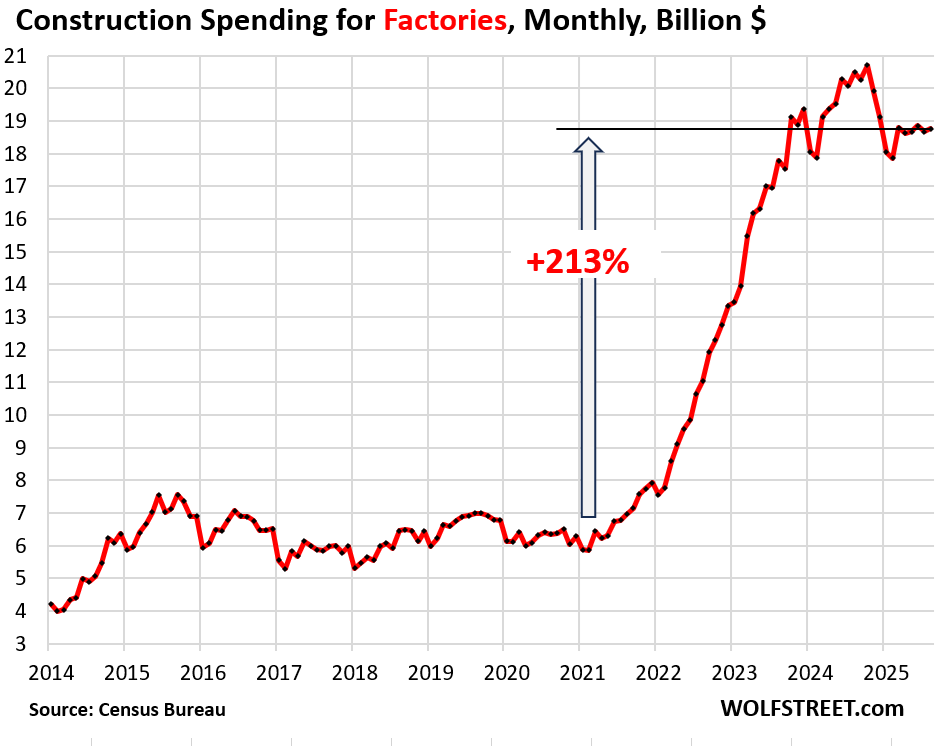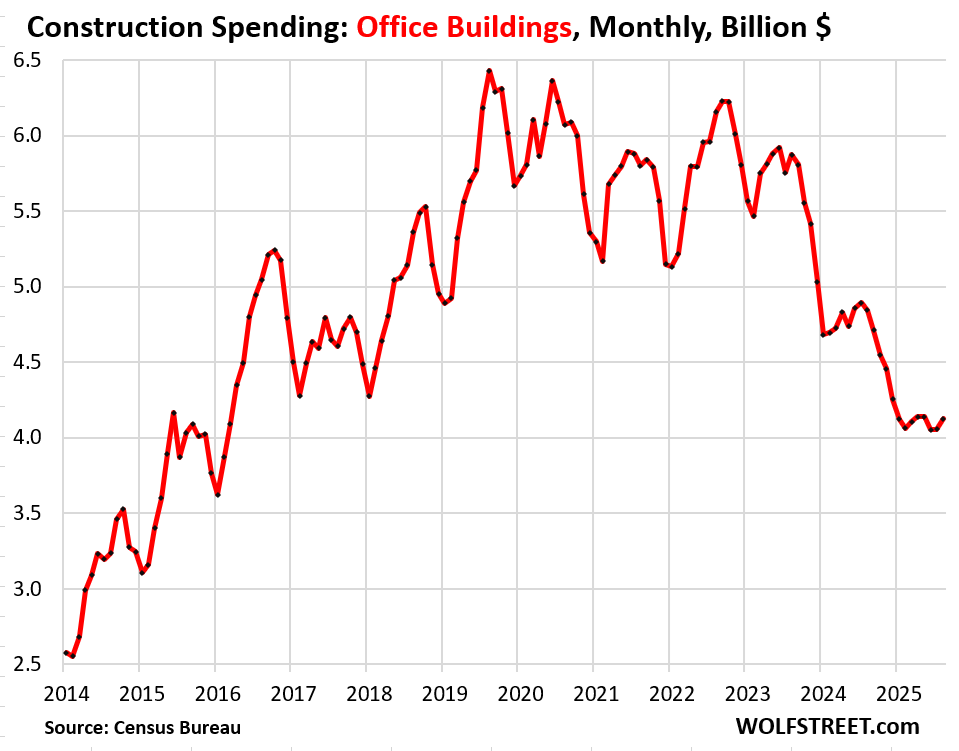But spending on factories dwarfs spending on data centers.
By Wolf Richter for WOLF STREET.
Of the hundreds of billions of dollars spent on AI infrastructure over the past few years amid a massive AI spending mania, only a small portion went to the actual construction costs of data centers. The vast majority of the costs of a data center is in AI servers and the equipment to supply the servers with prodigious amounts of power. Construction spending on data centers covers only the cost of the building and land improvements, and costs associated with the building itself, such as HVAC equipment.
Data centers take years to plan and build, and the spending we see today has been planned some time ago. Nevertheless, construction costs of data centers show the trend of the AI spending mania.
Construction spending on data centers soared by 25% year-over-year, from the already red-hot pace a year ago, to $3.7 billion in August, up by nearly 400% since the beginning of 2021, according to the Census Bureau today. Over the past 12 months, $38 billion were spent on building data centers.

Construction cost inflation for nonresidential buildings rose only by 1.0% over the nearly three years since the beginning of 2023, after having flattened out from the 37% spike in 2021 and 2022, according to the Producer Price Index for Construction of Nonresidential Buildings through August.
With the PPI for construction costs up by only 1% since the beginning of 2023, and with spending on data center construction up by 219% over the same period, the red-hot construction spending boom on data centers over that period is not a result of construction cost inflation – but of the AI mania.

Construction spending on manufacturing plants has run over the six months through August at a pace of nearly $19 billion per month, up by 219% from the beginning of 2021, and up by 41% since the beginning of 2023, according to data from the Census Bureau today.
Over the past 12 months, construction spending on factories totaled $228 billion.
Construction of factories, though still at a red-hot pace, has slowed from the spike in 2024, possibly as construction resources have been pulled away by the mindboggling boom in data center construction, and amid reports of bottlenecks, shortages of skilled labor, and ICE hauling off workers from construction sites, such as from the Hyundai factory.
After decades of globalization, there is now a widespread rethink underway about production in the US. These facilities will all be highly automated plants that produce complex high-value products.
Within this total factory construction, spending on factories for computers, electronic, and electrical equipment has exploded by over 1,400% (by over 15 times!) since 2021, from $570 million to $8.86 billion, and now accounts for over half of total factory construction.
Other big factory construction categories include factories for motor vehicles and components, batteries, semiconductors, and for the chemical industry.
Factory construction spending ($18.8 billion in August) is 5 times the size of data-center construction spending ($3.7 billion in August).

Powerplant construction is a notoriously long, costly, and highly regulated process. Data centers require lots of power, and utilities or the data center providers, have to invest to build new capacity to generate this power, and they have to invest in the transmission infrastructure to get the power to the data centers. But this is a complex process and takes years.
Utilities and power generators are leery of spending billions of dollars on power plants for data centers that might never work out after the AI investment mania implodes, which would turn these investments into stranded assets.
Monthly construction spending on electric power installations, including power plants and transmission infrastructure, has run at a pace of nearly $10 billion a month this year ($9.8 billion in August), after two big waves of acceleration, starting in 2019.
Between August 2021 and August 2025, the monthly construction pace has risen by 29%. With the two waves of accelerations combined, so between August 2018 and August 2025, the pace of monthly construction spending has increased by 69%.
Powerplant projects that are being planned won’t show up in construction spending until on-site construction actually starts.

But spending on office building construction has plunged by 35% from the peak in August 2021 through August 2025. This does not include data centers. Some of this spending on office buildings is for buildings that were planned years ago, before the office segment of commercial real estate began to collapse, and that are being completed now.

Enjoy reading WOLF STREET and want to support it? You can donate. I appreciate it immensely. Click on the mug to find out how:
![]()


Markets Brace for a Make-or-Break Week. Nvidia, the Fed and Holiday Spending Take Center Stage.
Nvidia’s earnings may decide the fate of the entire AI rally, while key retail and consumer-spending data will signal how resilient the economy really is. With multiple Fed speakers on deck, this is one of the most important market weeks of the quarter.
Now if we could only get AI to build hyperscaler data centers in the Metaverse, pumping out Bored Ape NFTs, America would truly return to #1 in the global economy.
Wolf. Curious how this stacks up with data around wage increases in the labor needed to build out these factories.
I’m building a new facility outside of Chicago, and rate sheets for non-union electricians are $110-$130/hr now. Getting a simple 480V drop feels 2.5x more expensive versus the last time I built out a new facility in 2015, but memories are faulty. Curious what the data shows.
I just read a report on the shortage of electricians for data centers, and the hourly pay rate that experienced electricians can command were right in your ballpark. This was for installing the electrical lines and equipment in data centers and hooking it all up to the power source. So that part isn’t actually part of the construction cost of a data center, as I explained in the article.
Skilled labor in general is in short supply (we just talked about the shortage of high-level auto technicians the other day). Lots of people wasted their time in college when they should have gone to trade school and learned a trade.
” Lots of people wasted their time in college when they should have gone to trade school and learned a trade.”
Yeah, that’s an interesting point. I wonder how many new trade schools we will see popping up. Some junior colleges used to have really good vocational programs. I don’t know about now.
My home state of Connecticut has had technical high schools for over 50 years turning out trades people. I went to one between 1957 – 1961 and graduated as a mechanical draftsman. I immediately went to work on the board for a machinery manufacturer (Waterbury Farrell Foundry and Machine Company, now Textron).
The technical high school system is still active throughout the state and both my nephews graduated from the one I went to, one as a machinist, and the other as a tool and die maker. Both are fully employed in their trades.
The trade schools have upgraded their curriculum’s over the years to include computer related courses of study and training,
@Anthony A.
That’s good to hear!
(FYI – I also worked for Textron for a few years after they purchased the small company I was working at)
Anthony: that’s really cool that Connecticut has an abundance of trade schools. I’m sure once the word gets out that there’s money in the trades, as well as pathways to leadership and project management positions, tuition will go parabolic like it did at universities.
Wolf: Do you think skilled labor is in short supply because boomer parents steered their children away from the trades and into universities?
“…parents steered their children away from the trades and into universities”
My parents certainly did.
Meanwhile I made $200 in 2 hours swapping out a guy’s ABS pump yesterday.
Time was when I took Woodshop and Drafting in Junior High. The guys going to trade school also took Metal Shop.
@Mitry, yes, that’s exactly what happened. Starting in the late 1950s as the space race heated up, the focus from the White House on down was on creating more brain power to fuel the perceived demand for STEM and the “future of America” was about technology. We still had shop class when I was in high school (late 70s) but everyone was all about kids going to college, not becoming plumbers.
Fast forward to today, the trades are being taken over by technology (as Wolf noted with auto mechanics). HVAC is quickly becoming a technology driven trade, as is electrical. Parents grasping the impact of AI are rethinking their aversion to the trades.
What you don’t really want is a bunch of new trade schools popping up. The is already a shortage of qualified instructors right now, a big increase of demand would mean a lot of unqualified instructors — unless you were willing to pay experienced tradespeople what the could make in the field. Even then, not everyone has the gift of being a good educator (and it is gift, make no mistake).
The whole education industry needs to be torn apart and rebuilt to account for technology and AI. Much like every other industry, the established players will fight like crazed weasels to stop any progress that threatens their revenue models, so it’s an uphill slog all the way.
Today most companies will give you free “on the job” training to work as an electrician, plumber or HVAC guy. As a young guy without a family you can really save up a lot of cash working overtime durrign the week and working weekends.
ApartmentInvestor: a lot of those places with free training are bottom of the barrel outfits. If a young man is wise enough to work around and build up his skills at a variety of companies, free training might be an okay career move. Especially if he wants to become an independent contractor. If there’s no desire to start a contracting business, working for a union will give you better pay and job security. Better equipment and working conditions, too.
Same Situation here in Germany. The few really good and qualified craftsmen can work around the clock, because they are really getting so rare.
A lot of sloppy and un-motivated bums around, but they do not have the work ethics and quality standards as in the past.
The void is often filled by workers from Eastern European countries and although those guys are really working hard their work result cannot be compared to that of a qualified German craftsman, be it plumbing or woodwork or what have you.
Most of the Gen-Z Kid are rather going to Uni to get a useless degree in underwater basket-weaving (thanks Dave Ramsay for that word) or Genderallala science!
How can you maintain your infrastructure and industry under such circumstances? Even housing demand cannot be taken care of!
Earn an engineering degree, it will pay you back,
From personal experience as a truck driver’s son.
Good post because you referenced the hidden cause of American angst.
Survival is no longer an acceptable life style.
Yes, but you are also learning the bad habits of whomever is working with you. You learn the mechanics, but you don’t understand things like the refrigeration cycle, which underlies the mechanics.
The best people in any trade learned on the job – and then went on and learned how to do it right.
The worst people in any trade learned on the job and never even realized there was a right way to do stuff.
So the Trump economy, despite having supposedly been “about jobs”, is all-in on AI, down a bit from Biden on factories, and down on renewables in favor of burning more fossil fuels to power said AI. So, actually taking the path of accelerating the destruction of jobs right when that’s the opposite of what we need and what was promised. Interesting!
You’re over-interpreting this to fit your narrative. Like I said, planning, buying the property, and permitting for a factory takes a long time. Construction spending begins to happen after everything else has been done, and construction actually starts. The Trump effect, if any, isn’t even visible in this data yet. People today have zero patience. Everything has to be instant. They have no idea how many years it takes to pull off a multibillion-dollar project, from when the idea is first hatched.
Bitcoin just wiped out all of its 2025 gains. What a crypto winter could look like.
Bitcoin is still at an inexplicably high $91,000. Not much of a “crypto winter.”